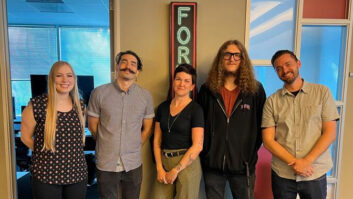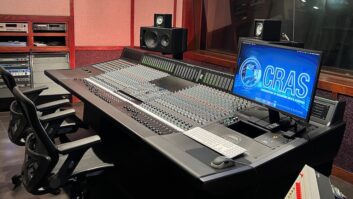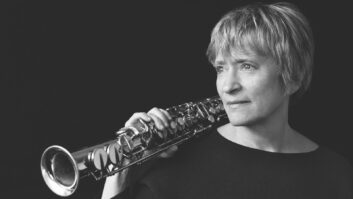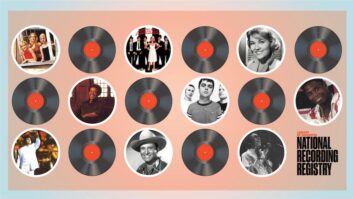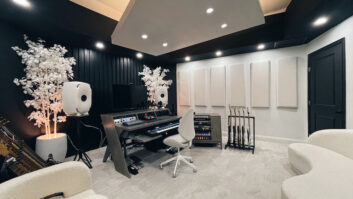Over the past decade, many new recording schools have opened their doors for business. With very few exceptions, these institutes of higher learning fall into one of two categories: the specialized trade school or a dedicated recording program within an existing college or university. This trend appears not only to be a reflection of the industry’s need for trained audio professionals, but to mirror the desire of many aspiring musicians, producers and recording engineers who are chasing their dream to work in the recording industry — a textbook case of supply and demand.
On the downside, a degree in audio engineering does not guarantee a job and may not give the graduate all of the skills that he or she needs to be employable in the real world. The key that unlocks this door is a school that has demonstrated its ability to interface with the industry and offers a curriculum that covers not only recording basics, but training that addresses the specialized needs of the state-of-the-art, 21st century facility as well. An innovative and effective internship and job placement program is also an important factor in choosing a school. Enter the Conservatory of Recording Arts and Sciences in Tempe, Ariz.
The Conservatory (henceforth known as CRAS) is one of the schools that has emerged from the pack, receiving accolades from its students, graduates and from the pro audio community at large. Without a doubt, CRAS has come a long way in the past decade. While enrollment at CRAS is relatively small (currently no more than 400 students a year) in comparison to other recording schools, this is not necessarily a bad thing, and, in fact, it helps to create a sense of community that is shared by the students, instructors and administrators.
MY DAY AT CRAS
Being an audio professional in the Phoenix metro area, I had heard a number of stories over the years (both good and bad) about CRAS and decided that the best way to check it out was from the inside. About the same time I began this article, an old friend of mine asked me to pinch-hit for him and substitute teach his Web audio class at CRAS. I was to teach two four-hour classes of 12 students each who were just finishing up the program and getting ready to head off to their seven-week internships. These two groups were my best shot at finding out the good, the bad and the ugly of the school’s curriculum. This was also my opportunity to find out what the students had learned during their time at CRAS, and I was interested to see if their career aspirations had solidified or changed at all.
After wrapping things up with each class, I explained that I was writing an article about CRAS and I wondered if they had any input for me. I was really surprised that there were no major complaints about the program and that every student I spoke with considered the time spent at CRAS a positive experience. Okay, one guy whined a little about the Conservatory’s lack of internship contacts in Kansas, and there was a general consensus among the students who I spoke with that there were not enough CD burners in the Pro Tools lab, but that was about it. Another student suggested that the best way for them to show me the depth of their CRAS experience was to play their final projects for me. As I listened to each of their demos (tracked and mixed on an SSL, no less), I was afforded the rare opportunity to see, hear and feel what they had learned at CRAS. There were definitely a few instances of musical taste being on vacation, but it was obvious that the majority of the students were well on their way to becoming audio professionals.
THE ADMINISTRATOR
When Kirt Hamm took over as administrator of CRAS in May of 1992, there were three students attending classes in a 500-square-foot facility. Fast-forward to 2001, and the Conservatory’s campus has grown to 14,500 square feet with a capacity for as many as 400 students per year. Today, CRAS is among the best-equipped and designed recording facilities in Arizona, if not the entire Southwest, and through Hamm’s vision and administration, it has become one of the most successful recording schools of its kind in North America.
As of this writing, there is a 12-month waiting list to attend CRAS, and during my informal tour of the campus, I posed the question of expansion to Hamm. “Although our students are patient and willing to wait to receive the best education, we would prefer that they didn’t have to,” he said. “We have always been very cautious about expansion, but believe that the time has finally come to make it happen. In my mind, change equals opportunity, and I insist upon capitalizing on opportunity to make our program even better. That’s really all I’m willing to say at this time, but there will be announcements detailing our expansion plans in the not-so-distant future.”
TAKING THE TOUR
Outward appearances can be deceiving, and there is no place where this is more evident than at CRAS. At first glance, the CRAS campus could easily be mistaken as a medical/dental office building in Any City, USA. But once you step into one of the Conservatory’s classroom/studios, the lack of exterior flash is no longer an issue.
The current curriculum at CRAS (now known as Master Recording Program II, or MRP II) is a 30-week program broken down into 10 three-week cycles, followed by a 280-hour internship that must be completed to graduate. Students are in the classroom for a combination of lecture and hands-on training four hours a day, five days a week, with some weekend classes as well. Also, the facilities are available to the students on a 24/7 basis. This not only allows the students time to work on their class projects, but it also gives them the opportunity to familiarize themselves with the extensive array of outboard and computer gear found in the studios and classrooms.
The curriculum at CRAS is varied and covers a wide range of subject matter, such as studio maintenance, networking and Internet applications, and a variety of valuable music business subjects, including studio and session etiquette. With computer literacy becoming a necessary skill in the modern recording facility, students at CRAS are also taught trouble-shooting and maintenance for the Macintosh platform as well as basic sequencing skills. By interfacing with pro audio manufacturers, CRAS is able to offer certification programs for Waves plug-ins, SIA Smaart Sound and TC Electronic. Also, as of this writing, CRAS is the only proprietary recording school in the U.S. that is an Avid Authorized Education Center offering the Pro Tools 135 and 235 class and certification.
Each studio at CRAS was designed by Jerry Davis of Jeremiah & Associates, with additional input coming from the various instructors and staff members. Studios A through C have a traditional live-end/dead-end design and have dedicated machine rooms to keep the heat and extraneous noise out of the classroom.
The heart and soul of Studio A is a 48-input SSL 4056 G Plus console and a Studer A827 24-track (analog 2-inch) machine. Add to that a Tascam DA-98, two DA-38s and a number of Tascam 24-bit hard disk recorders and you have a wide assortment of work formats. Outboard gear includes equipment from Lexicon, TC Electronic, Eventide, Manley, Teletronix and UREI. This is the room where each student’s final project is tracked and mixed. The only complaint I’ve heard about this room comes from some of the students: They want it all to themselves. So do I.
Studio B shares a joint tracking room with Studio C and they are, for all practical purposes, acoustically identical. Some of the differences between the two rooms include a Neotek Elite (32-input) console in Studio B and a Neve VR 48 with flying faders in Studio C. Both rooms have their own Otari MTR-90 24-track (2-inch analog) machine, with three Tascam DA-88s and lots of outboard gear. During my official visit, the joint tracking room was being used for a scoring session, with a small acoustic ensemble of local musicians supplying the talent.
Studio D is a 5.1 surround sound classroom equipped with a Mac G4 (running Pro Tools 5.1) and two Tascam TM-D4000 digital mixers cascaded together. The surround monitoring in Studio D is via five Hafler TRM-8 speakers and two 12-inch subwoofers. The Macintosh G4 in this room also shares space with a Windows computer running several audio applications.
The Pro Tools Lab features six Macintosh G4 computers with Pro Tools 5.1 (TDM) and Digidesign interfaces (882 and 884/24) supplying the AD/DA conversion.
The Digital Recording Lab is equipped with six Macintosh G3 computers running the latest version of Logic Audio and Cubase. Each workstation also has a Tascam DA-38, a Tascam TM-D1000 digital board, and a Korg 01W synthesizer installed in an Omnirax Workstation.
The Live Sound classroom has two Soundcraft Spirit 40 input consoles and loudspeaker arrays from Community. The Live Sound curriculum at CRAS was designed by noted mixer Robert Scovill, but for the past two years, it has been taught exclusively by CRAS instructor Keith Morris. The classroom was designed to create a realistic concert stage environment for the purpose of familiarizing students with real-world situations that they’re likely to encounter. The only experience missing from the live sound classroom at CRAS is the typical 22-hour workday.
The Studiomaster classroom/lab is equipped with six workstations, each containing a Studiomaster MDC8 24-input console and three Alesis XT-20 ADATs. There is the requisite outboard gear and an Otari MX-5050 ¼-inch half-track (analog) for mixdown.
The music business classroom includes an extensive reference library that gives students access to general music business information. The Music Business curriculum at CRAS covers publishing, copyright law, contracts, studio business, and much more. There are a total of 48 classroom hours devoted to this area.
THE INTERN PROGRAM
There’s a reason that CRAS is proud of the success of their Intern program. Many Conservatory graduates end up as employees at the facilities where they completed their internship. Hamm states, “It’s part of our master plan to have our students become such an integral part of the facility that they’re interning at, that when the seven weeks are up, they’re asked to stay on as an employee.” Over the years, CRAS has forged strong relationships with a number of recording facilities in Los Angeles, New York and Nashville, and has used these connections to place their interns for the last phase of their training. According to Hamm, “It’s not unusual to have a studio contact us and ask for an intern that can fill a specific need.”
In many cases, applying for an internship is like applying for a job, and the staff at CRAS are intent on teaching their students the necessary interviewing skills that will help them to land a job. This includes teaching students to create an effective resume and how to have the right attitude. Regardless of their level of skill and talent, no one likes a cocky intern, and even more to the point, not many potential employers would hire one. CRAS students head out the door for their internship knowing their place on the studio food chain. CRAS graduates are employed in all areas of the recording industry including six at Tascam, two at Waves and nine at The Enterprise in Burbank, Calif.
The program at CRAS is intense, fast-moving and, in comparison to other proprietary recording schools, quite affordable. Many of the soon-to-be CRAS graduates who I spoke with felt that they were more than ready to pursue entry-level positions in the recording industry, and that their time at CRAS had prepared them for future challenges. There was also a consensus among the students that their education at CRAS had given them a good idea of which areas of pro audio they would specialize in and, ultimately, a leg up in regards to advancement.
Ron Simpson is a freelance writer and Web audio technologist based in Phoenix, Ariz.
